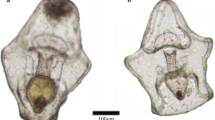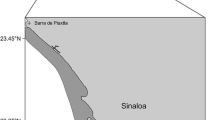Abstract
This study investigated the role of predators in preventing competitive exclusion among three closely related armoured catfishes (Callichthys callichthys, Hoplosternum littorale and H. thoracatum) that occur synthopically in multi-predator freshwater swamps of Suriname, South America. The potential impact of predation on armoured catfish was determined by combining laboratory measurements of predation rates on five early developmental stages of the armoured catfish H. thoracatum for 24 aquatic predators with field studies of the density of the predators in the swamps. The contribution of a particular predator to the total predation pressure on its prey was determined to a large extent by the density of the predator in the swamp. Seemingly innocuous predators with low or moderate predation rates in the laboratory may be extremely important in the swamps due to their high abundance. Small-sized omnivorous fishes and aquatic invertebrates were major predators of early developmental stages of armoured catfish. Both qualitative and quantitative ontogenetic changes in the predation pressure on armoured catfish were observed. Major predation on eggs, larvae and juveniles of H. thoracatum resulted from a different set of predators in each developmental stage of the prey. In all developmental stages of H. thoracatum the predation pressure involved several predator species and not a single, dominant predator. The potential predation pressure of the 24 predators taken together and the number of predators that were able to prey on H. thoracatum decreased sharply with increasing age (size) of the prey. Even if egg (nest) predation is prevented by the guarding male, the potential impact of the 24 predators on the populations of armoured catfish is large. Predation may account for the high mortality of H. thoracatum observed in the swamps. The high predation pressure on callichthyid catfishes may help to explain the coexistence of three closely related and morphologically quite similar armoured catfishes in Surinamese swamps.
Similar content being viewed by others

References
Alexander GR (1979) Predators of fish in coldwater streams. In: Stroud RH, Clepper H (eds) Predator-prey systems in fisheries management. Sport Fishing Institute, Washington DC, pp 153–170
Bailey KM, Houde ED (1989) Predation on eggs and larvae of marine fish and the recruitment problem. Adv Mar Biol 25: 1–83
Beebe W (1946) Field notes on the snakes of Kartabo, British Guiana and Caripito, Venezuela. Zoologica 31: 11–52
Birch LC (1957) The meanings of competition. Am Nat 91: 5–18
Boujard T, Moreau Y, Luquet P (1991) Entrainment of the circadian rhythm of food demand by infradian cycles of light-dark alternation in Hoplosternum littorale (Teleostei). Aquat Living Resour 4: 221–225
Cerri RD (1983) The effect of light intensity on predator and prey behaviour in cyprinid fish: factors that influence prey risk. Anim Behav 31: 736–742
Connell JH (1975) Some mechanisms producing structure in natural communities: a model and evidence from field experiments. In: Cody ML, Diamond JM (eds) Ecology and evolution of communities. Belknap, Cambridge, pp 460–490
Connell JH (1978) Diversity in tropical rainforests and coral reefs. Science 199: 1302–1310
Dahlberg MD (1979) A review of survival rates of fish eggs and larvae in relation to impact assessments. Mar Fish Rev US 41: 1–12
De Lafontaine Y, Leggett WC (1988) Predation by jellyfish on larval fish: an experimental evaluation employing in site enclosures. Can J Fish Aquat Sci 45: 1173–1190
Dominey WJ (1981) Anti-predator function of bluegill sunfish nesting colonies. Nature 290: 586–588
Duplaix N (1980) Observations on the ecology and behavior of the giant river otter Pteronura brasiliensis in Suriname. Rev Ecol Terre Vie 34: 496–620
Foster SA, Garcia VB, Town MY (1988) Cannibalism as the cause of an ontogenetic shift in habitat use by fry of the threespine stickleback. Oecologia 74: 577–585
Fryer G, Iles TD (1955) Predation pressure and evolution in Lake Nyasa. Nature 176: 470
Fryer G, Iles TD (1972) The cichlid fishes of the great lakes of Africa. Oliver and Boyd, Edinburgh
Goulding M, Carvalho ML, Ferreira EG (1988) Rio Negro: rich life in poor water. SPB Academic, The Hague
Greene CH (1986) Patterns of prey selection: implications of predator foraging tactics. Am Nat 128: 824–839
Hewitt RP, Theilacker GH, Lo NCH (1985) Causes of mortality in young mackerel. Mar Ecol Prog Ser 26: 1–10
Heyer WR (1969) The adaptive ecology of species groups of the genus Leptodactylus (Amphibia, Leptodactylidae). Evolution 23: 421–428
Hobson ES (1979) Interactions between piscivorous fishes and their prey. In: Stroud RH, Clepper H (eds) Predator-prey systems in fisheries management. Sport Fishing Institute, Washington DC, pp 231–242
Holt RD (1977) Predation, apparent competition, and the structure of prey communities. Theor Popul Biol 12: 197–229
Hoogland R, Morris D, Tinbergen N (1957) The spines of sticklebacks (Gasterosteus and Pygosteus) as means of defence against predators (Perca and Esox). Behaviour 10: 205–236
Hostache G, Vallat P, Tessier C (1990) Maîtrise du cycle d'élevage de l'atipa. Nature Guyanaise 4: 33–41
Huet M (1972) Enemies and diseases of fish. I. Enemies of fish. In: Texbook of fish culture. Fishing News Books, Farnham, pp 360–364
Ims RA (1990) The ecology and evolution of reproductive synchrony. Trends Ecol Evol 5: 135–140
Jackson PBN (1961) The impact of predation, especially by the tiger-fish (Hydrocyon vittatus Cast.) on African freshwater fishes. Proc Zool Soc Lond 136: 603–622
Janzen DH (1970) Herbivores and the number of tree species in tropical forests. Am Nat 104: 501–528
Johannes RE (1978) Reproductive strategies of coastal marine fishes in the tropics. Environ Biol Fish 3: 65–84
Knöppel HA (1970) Food of Central Amazonian fishes. Amazoniana 2: 257–352
Kramer DL, Graham JB (1976) Synchronous air breathing, a social component of respiration in fishes. Copeia 1976: 689–697
Liley NR, Seghers BH (1975) Factors affecting the morphology and behaviour of guppies in Trinidad. In: Baerends GP, Beer C, Manning A (eds) Function and evolution in behaviour. Claredon, Oxford, pp 92–118
Lima SL (1992) Life in a multi-predator environment: some considerations for anti-predator vigilance. Ann Zool Fenn 29: 217–226
Lowe-McConnell RH (1964) The fishes of the Rupununi savanna district of British Guiana, South America. Part 1. Ecological groupings of fish species and effects of the seasonal cycle on the fish. Zool J Linn Soc Lond 45: 103–144
Lowe-McConnell RH (1969) Speciation in tropical freshwater fishes. In: Lowe-McConnell RH (ed) Speciation in tropical environments. Academic Press, London, pp 52–75
Lowe-McConnell RH (1987). Ecological studies in tropical fish communities. Cambridge University Press, Cambridge
MacArthur RH, Levins R (1967) The limiting similarity, convergence, and divergence of coexisting species. Am Nat 101: 377–385
MacArthur RH, Wilson EO (1967) The theory of island biogeography. Princeton University Press, Princeton
McGurk MD (1986) Natural mortality of marine pelagic fish eggs and larvae: role of spatial patchiness. Mar Ecol Prog Ser 34: 227–242
McKaye KR (1984) Behavioural aspects of cichlid reproductive strategies: patterns of territoriality and brood defence in Central American substratum spawners and African mouth brooders. In: Potts GW, Wooton RJ (eds) Fish reproduction: strategies and tacties. Academic Press, London, pp 245–273
McLean EB, Godin J-GJ (1989) Distance to cover and fleeing from predators in fish with different amounts of defensive armour. Oikos 55: 281–290
Menge BA, Sutherland JP (1987) Community regulation: variation in disturbance, competition, and predation in relation to environmental stress and recruitment. Am Nat 130: 730–757
Mol JH (1993a) Aquatic invertebrates of the coastal plain. In: Ouboter PE (ed) The freshwater ecosystems of Suriname. Kluwer, Dordrecht, pp 113–131
Mol JH (1993b) Structure and function of floating bubble nests of three armoured catfishes (Callichthyidae) in relation to the aquatic environment. In: Ouboter PE (ed) The freshwater ecosystems of Suriname. Kluwer, Dordrecht, pp 167–197
Mol JH (1994) Effects of salinity on distribution, growth and survival of three neotropical armoured catfishes (Siluriformes-Callichthyidae). J Fish Biol 45: 763–776
Mol JH (1995) Ontogenetic diet shifts and diet overlap among three closely related neotropical armoured catfishes. J Fish Biol 47: 788–807
Mol JH (1996) Reproductive seasonality and nest-site differentiation in three closely related armoured catfishes (Siluriformes: Callichthyidae). Environ Biol Fish 45: 363–381
Oiestad V (1985) Predation on fish larvae as a regulatory force, illustrated in mesocosm studies with large groups of larvae. N Atlantic Fish Organization Council Stud 8: 25–32
Paine RT (1966) Food web complexity and species diversity. Am Nat 100: 65–75
Pepin P (1987) Influence of alternative prey abundance on pelagic fish predation of larval fish: a model. Can J Fish Aquat Sci 44: 222–227
Peters RH (1983) The ecological implications of body size. Cambridge University Press, Cambridge
Power ME (1984) Depth distributions of armored catfish: predator-induced resource avoidance? Ecology 65: 523–528
Prejs A (1987) Risk of predation and feeding rate in tropical freshwater fishes: field evidence. Oecologia 72: 259–262
Reimchen TE (1994) Predators and morphological evolution in threespine stickleback. In: Bell MA, Foster SA (eds) The evolutionary biology of the threespine stickleback. Oxford University Press, Oxford, pp 240–276
Richards OW, Davis RG (1977) Imm's general textbook of entomology, 10th edn. Chapman and Hall, London
Richter CJJ, Nijssen H (1980) Notes on the fishery potential and fish fauna of the Brokopondo reservoir (Surinam). Fish Manage 11: 119–130
Rogers DJ (1972) Random search and insect population models. J Anim Ecol 41: 369–383
Rojas-Beltran R (1986) Evolution du peuplement ichthyologique d'un petit cours d'eau temporaire de la savane littorale de Guyanc. Cybium 10: 263–277
Root RB (1967) The niche exploitation pattern of the blue-gray gnatcatcher. Ecol Monogr 37: 317–350
Roughgarden J, Feldman M (1975) Species packing and predation pressure. Ecology 56: 489–492
Royama T (1971) A comparative study of models for predation and parasitism. Res Popul Ecol Suppl 1: 1–91
Saul WG (1975) An ecological study of fishes at a site in upper Amazonian Ecuador. Proc Acad Nat Sci Philadelphia 127: 93–134
Schaller GB, Crawshaw PG (1982) Fishing behavior of Paraguayan caiman (Caiman crocodilus) Copeia 1982: 66–72
Seijas AE, Ramos S (1980) Caracteristicas de la dieta de la baba (Caiman crocodilus) durante la estacion seca en las sabanas moduladas del estado Apure, Venezuela. Acta Biol Venez 10: 373–389
Sih A, Crowley P, McPeek M, Petranka J, Strohmeier K (1985) Predation, competition, and prey communities: a review of field experiments. Annu Rev Ecol Syst 16: 269–311
Singh TB (1978) The biology of the cascadura Hoplosternum litorale Hancock 1834 with reference to its reproductive biology and population dynamics. PhD thesis University of the West Indies, Trinidad and Tobago
Soluk DA (1993) Multiple predator effects: predicting combined functional response of stream fish and invertebrate predators. Ecology 74: 219–225
Ware DM (1975) Relation between egg size, growth, and natural mortality of larval fish. J Fish Res Bd Can 32: 2503–2512
Werner EE (1986) Species interactions in freshwater fish communities. In: Diamond J, Case TJ (eds) Community ecology. Harper and Row, New York, pp 344–357
Wilbur HM, Fauth JE (1990) Experimental aquatic food webs: interactions between two predators and two prey. Am Nat 135: 176–204
Winemiller KO (1989) Ontogenetic diet shifts and resource partitioning among piscivorous fishes in the Venezuelan llanos. Environ Biol Fish 26: 177–199
Witte F, Goldschmidt T, Wanink J, Van Oijen M, Goudswaard K, Witte-Maas E, Bouton N (1992) The destruction of an endemic species flock: quantitative data on the decline of the haplochromine cichlids of Lake Victoria. Environ Biol Fish 34: 1–28
Wootton RJ (1990) Ecology of teleost fishes. Chapman and Hall, London
World Conservation Monitoring Centre (1992) Global biodiversity: status of the earth's living resources. Chapman and Hall, London
Zaret TM, Paine RT (1973) Species introduction in a tropical lake. Science 182: 449–455
Zaret TM, Rand AS (1971) Competition in tropical stream fishes: support for the competitive exclusion principle. Ecology 52: 336–342
Author information
Authors and Affiliations
Rights and permissions
About this article
Cite this article
Mol, J.H. Impact of predation on early stages of the armoured catfish Hoplosternum thoracatum (Siluriformes-Callichthyidae) and implications for the syntopic occurrence with other related catfishes in a neotropical multi-predator swamp. Oecologia 107, 395–410 (1996). https://doi.org/10.1007/BF00328457
Received:
Accepted:
Issue Date:
DOI: https://doi.org/10.1007/BF00328457



